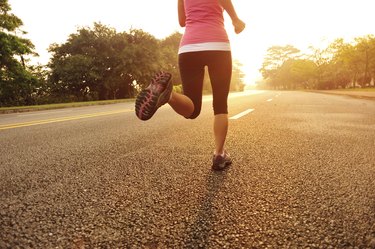
Running helps you burn excess calories and fat, which contributes to weight loss, as long as you establish a calorie deficit. Daily runs, like other weight-loss strategies, burn fat from all over your body, including your thighs. Although one mile a day may be enough to produce gradual weight loss, your success depends on other factors, including your diet and cross-training strategies. Check with your doctor before starting a running program if you have a history of heart or orthopedic problems.
Calories Out
Video of the Day
Your body weight and the intensity of your workouts affect the number of calories you burn running one mile. For example, a 154-lb. individual burns roughly 9.8 calories a minute running at 5 mph. At this speed, it takes 12 minutes to run a mile, effectively burning 117 calories. The higher your body weight, the more calories you burn. The same run would burn 145 calories for an individual that weighs 200 lbs. Although you burn more calories per minute the faster you run, you also finish the mile faster. The difference in running a 7.5-minute mile and a 12-minute mile is only around six to eight calories.
Video of the Day
Calories In
To lose weight in general, you need to burn more calories than you consume. Running one mile a day burns enough calories to produce around 1 lb. per month of weight loss, if you're already maintaining your weight on your current eating plan. Because weight loss is not limited to your thighs, it may take several weeks or months to notice a sizable difference. If you've been gaining weight on your current diet, running may help with weight maintenance, but you'll need to change your eating habits in order to lose weight.
Muscle Considerations
Running tones and strengthens the muscles in your lower body, including your thigh muscles. Although bulking up isn't likely during weight loss, running helps you retain muscle and may lead to an increase in muscle mass in your lower body. If you develop muscle easily, the size of your thigh muscles may increase with a regular running program. However, running only one mile a day while maintaining a calorie deficit will have a greater impact on fat loss than on muscle gain.
Cross-Training
Lower-impact activities such as walking and yoga make effective counterparts to a moderate running routine. Adding other physical activities to your running regimen helps increase your calorie deficit, improve your fitness and give your running muscles a break. Plus, low-impact activities exert less force on your lower body, which makes building muscle mass less likely, notes the American Council on Exercise. Combining running with less intense exercise maximizes calorie burn while providing the balance you need to lose inches in your thighs and elsewhere.